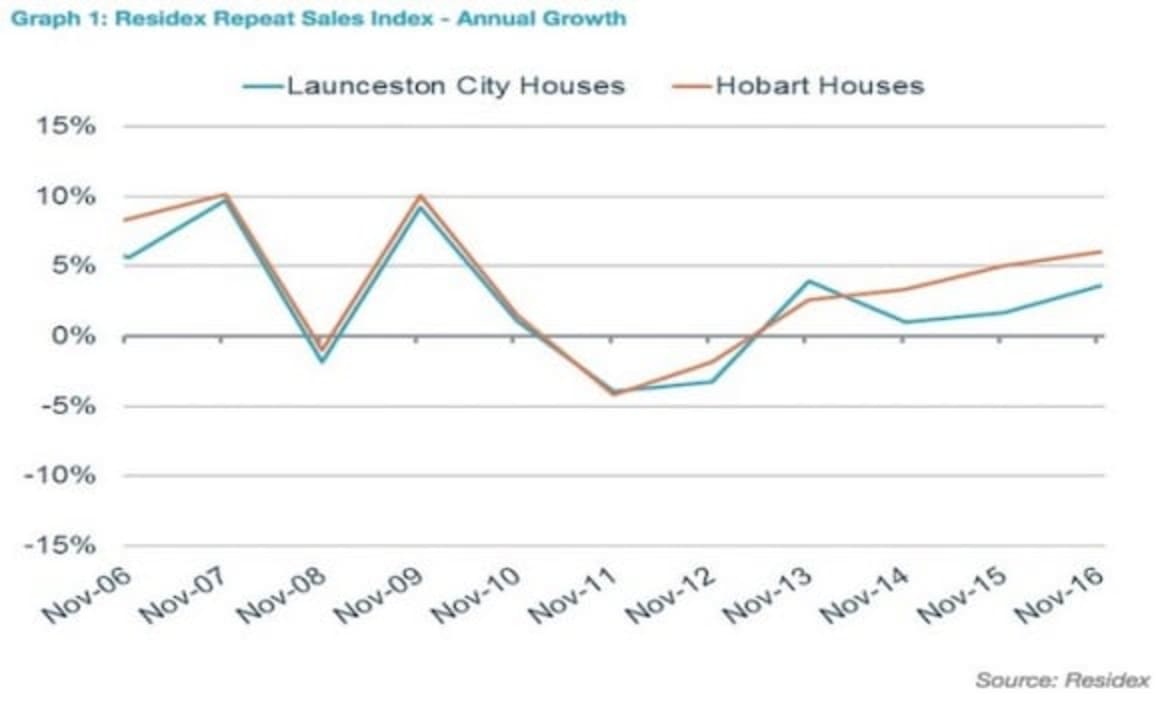Melbourne pips Sydney in 10 year growth for house prices: Residex

Melbourne has narrowly pipped Sydney in 10 year growth for house prices, according to the latest Residex data.
But Sydney comes out on top over the decade for apartment price growth.
In the year to November 2016, Australian dwelling values saw an increase of 4.49%.
"This is above the 3.77% annual growth average since 2009, when Australia felt the effects of the 2008 GFC," said Eliza Owen, the market analyst for Onthehouse.com.au.
However she noted the growth was below the November 2015 figure of 6.63%.

The Residex data indicated the highest growth for the November quarter was in Hobart houses, where the median repeat sale value increased 2.39% in the last 3 months.
Hobart houses also had the strongest growth of the major aggregate markets in 2016, with a 6.01% increase in the year to November.
"While these figures are low relative to the double digit growth seen in 2014-15 (for example Sydney houses increased 15.71% in the year to November 2015), major Australian housing markets are likely to return to norms of single digit dwelling growth as softening economic conditions catch up with dwelling demand," Owen advised.
ACT houses increased in value over the quarter, and displayed a healthy return of 3.32% over the year.
Major Queensland and South Australia markets remained flat over the quarter, though some markets outside of the capital cities pushed up regional growth figures.
Hobart dwelling values were expected to increase over 2016 as those priced out of the Sydney and Melbourne markets looked elsewhere for affordable capital growth strategies.
The latest Residex State Market Report highlighted it was important to keep in mind that Tasmania still has geographical challenges with freight costs and labour force limitations.
"However, interstate migration to the area may increase due to the aforementioned growth factors, which would also bring new skills and services the area.
"Furthermore, as Hobart becomes more expensive due to higher interstate investment, and assuming that demand remains strong in 2017 (which it may not, given recent GDP indicators), spill-over of growth may occur in other parts of the island, such as the second largest city in Tasmania after Hobart - Launceston.
"Launceston has some solid growth fundamentals, including tertiary education institutions, shopping outlets and beautiful historical buildings which promote tourism and dwelling demand for sought-after aesthetics."
Already, 2016 has seen a 4.65% increase in Launceston house values and a 1.68% rise in unit values.
Graph 1 shows the similarity in growth cycles across the two cities, though there was a slight growth divergence between the cities toward the end of 2013.

The report noted Melbourne houses and units were also strong performers in the November quarter, with quarterly growth of 2.18% and 1.57% respectively.
Despite persistently high prices, Sydney houses and units were not far behind, increasing 2.18% and 1.30%.
Sydney and Melbourne continued to be popular with investors as well as overseas and interstate migrants over 2016.
According to ABS lending data from October this year, approximately 49% of new loans (excluding those for re-financing) were comprised of investors.
Part of the resurgence in investor activity may be explained by expansionary monetary policy.
In September, Sydney dwellings experienced an uplift in annual capital growth - following the August rate cut decision - while Melbourne growth continued to ease.
However, as the rate of capital gain across Melbourne has typically shown a slight lag on Sydney, Melbourne could also see growth rates pushed up in Q1 2017.
These movements are displayed in Graph 2.

Given the fragility of the Australian economy in labour and growth figures, a steady cash rate target may be expected over the first quarter of 2017, Eliza Owen tipped.
"Despite low interest rates potentially slowing the downswing in Sydney and Melbourne, a decline in government expenditure and increased mortgage rates for investors from major banks may see a steady reduction in the rate of capital gain in these markets during 2017," she added.